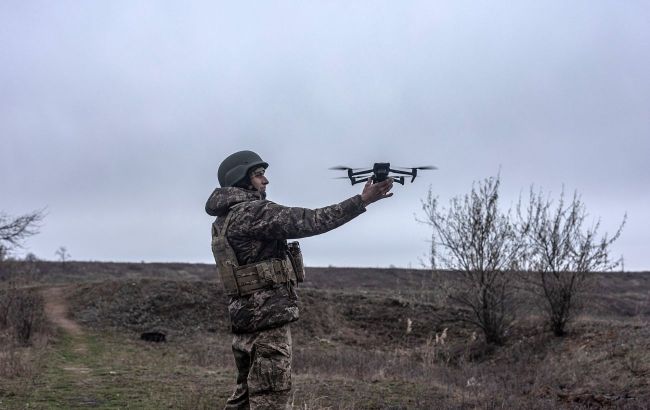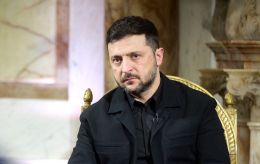Drone battle: Ukraine's need for FPV and potential impact of million drones on war's course
 The Ukrainian soldier launches an FPV drone (Photo: Getty Images)
The Ukrainian soldier launches an FPV drone (Photo: Getty Images)
The Russian-Ukrainian war has taken combat drones to a new level, especially FPV drones, which effectively target enemy personnel and equipment, far surpassing the cost of such UAVs. More about FPV drones and whether a million drones can ensure victory in the material by RBC-Ukraine.
The article was prepared using data from Wikipedia, material from Defense Express and Mlitarnyi specialized resources, statements by President Volodymyr Zelenskyy, government representatives, and military command, along with comments from experts Oleksandr Kovalenko and Oleksandr Musiienko.
What are FPV drones?
FPV drones, with video transmission function through a camera on the UAV itself, stand out in speed, precision, and control methods compared to other drones. Operators maneuver them using a controller and goggles, providing a first-person view (FPV).
While FPV drones are used for entertainment, panoramic video shooting, and live event streaming in civilian life, they're capable of carrying payloads, being agile, and changing direction swiftly, with some models reaching speeds of over 100 km/h.
In the Russian-Ukrainian war, FPV drones refer to high-speed quadcopters used for reconnaissance, observation, delivering ammunition, and even functioning as kamikazes, attaching a combat payload. In skilled hands, they become highly precise weaponry.
Ukrainian forces actively utilize FPV drones across various divisions since the initial phase of the full-scale invasion: Armed Forces, Security Service of Ukraine, Border Guards, National Guard, and Defense Intelligence operatives, among others. They regularly release footage. For instance, the 72nd separate mechanized brigade named after Black Zaporozhians recently destroyed a heavy flamethrower system Solntsepyok using these drones, estimated at $15 million.
"Ukrainian kamikaze drones for Russians are a 'heavenly punishment.' Using FPV drones offers the advantage of accessing areas where artillery cannot reach," mentioned Volodymyr Fitio, the spokesperson for the Ground Forces.
Even the Russian dictator, Vladimir Putin, acknowledges the threat. According to him, they were previously disregarded, assumed to be "some plywood," yet the FPV drone attacks inflict significant losses.
Currently, the Russian side is also increasing production and usage. According to the non-governmental media Agency. News, approximately 40 manufacturing units in Russia produce 400 to 5,000 units monthly, with 90% assembled from Chinese components.
Defense Express analysts note that if occupiers manage to mass-produce and supply thousands of FPV drones to the front, Ukrainian forces will face a serious challenge. Currently, our military employs UAVs at least three times more frequently than the Russians. However, the adversary persistently matches our intensity of strikes.
FPV drones in warfare: Advantages and disadvantages
The modern FPV drone is a customizable assembly that allows for the creation of an aircraft tailored to specific needs. Engines, frames, batteries, and other components are selected depending on the mission, after which a combat payload, often explosive, is added.
Employing an FPV drone guarantees sniper-like precision and provides a view akin to being in the cockpit through specialized gear. Other advantages include high speed and maneuverability. There are instances where kamikaze drones have successfully targeted tanks by entering through the hatch.
One of the primary advantages is the cost. Prices range from $500-600 to $1,000. Despite this, they can destroy equipment and military machinery hundreds or thousands of times more expensive. Moreover, production based on racing quadcopters can start at $200 per unit.
 Photo: The advantage of FPV drones lies in their affordability, precision, and maneuverability (Vitalii Nosach/RBC-Ukraine)
Photo: The advantage of FPV drones lies in their affordability, precision, and maneuverability (Vitalii Nosach/RBC-Ukraine)
FPV drones are manually operated, not linked to GPS satellite navigation, making them less susceptible to electronic warfare measures. However, if enemy jamming attacks any radio frequency the drone uses, video transmission signals and piloting commands are disrupted.
Several drawbacks are also noted. Firstly, to carry a potent combat payload, the structure needs to be lightweight, requiring the use of lightweight batteries that provide only a few minutes of operation.
Secondly, the actual destructive power is limited. When it comes to FPV drones, the combat payload weighs approximately 1 kg. Therefore, incapacitating a tank is much more challenging than with an anti-tank missile. Destroying heavy armored vehicles with a drone strike requires several factors to align.
Thirdly, a high level of pilot training is essential. While a basic course on a quadcopter like Mavic takes five days, mastering a combat FPV drone requires two to three weeks. Pilots need exceptional reaction speed, finger dexterity, and a strong vestibular system. For instance, those who experience motion sickness in a car won't be able to operate a drone through goggles. Additionally, piloting is complicated because, unlike the Mavic, there's no stabilization, making hovering an advanced skill.
Why FPV drones are needed on the front line?
The Ukrainian military is extensively deploying FPV drones out of necessity, not luxury. Primarily due to a shortage of artillery shells. European allies are unable to supply the promised million munitions, and the US aid package for Ukraine in 2024 will not be approved until at least January. This compels the Defense Forces to conserve resources. Presently, in artillery duels, there are 5-7 Russian shells for every Ukrainian one.
As stated by the commander of the operational-strategic group Tavria, Oleksandr Tarnavskyi, in an interview with Reuters, there was a particularly acute shortage of 122mm and 152mm caliber munitions.
"And today these problems exist across the entire front line. The volumes that we have today are not sufficient for us today, given our needs," he said.
It's worth noting that the 122mm and 152mm caliber shells are required for Soviet-era artillery. Apparently, Eastern European partners have transferred all they could from their stocks over the two years of the war. Ukraine is building up its capacities using the inventory from the USSR era, but it's evident that the deficit is here to stay.
According to Deputy Minister of Defense Ivan Havryliuk, drone kamikazes could serve as a temporary solution.
As for artillery ammunition, this issue will continue to arise. Therefore, in Ukraine it was decided to resolve these issues by creating a powerful UAV production," Havryliuk said in an interview with BBC.
Military expert and former spokesman for the General Staff of the Ukrainian Armed Forces, Vladyslav Seleznov, explains in a comment to RBC-Ukraine that much depends on the volume of production, but even a large number of FPVs will only partially cover the deficit in munitions. Specifically, drones are incapable of destroying firing points, concrete structures, or defensive lines. They operate more as a surgical tool for pinpoint strikes on enemy machinery and weaponry.
The Militarnyi portal cites arguments from a serviceman of the Territorial defense forces with the call sign Tourist, who pilots a 10-inch FPV bomber called LuckyStrike, produced in Ukraine. According to him, Lucky drops a 1.5 kg payload from a height of up to 100 meters at a speed of 60 km/h. Thanks to the work of such drones, it becomes possible to preserve soldiers. And this is crucial because people remain the most valuable resource in war.
Million drones. How realistic is this and can it affect the course of the war?
Russian forces have launched an offensive on the eastern front, attempting to press Ukrainian defense forces from positions in the south. Footage from Avdiivka, the left bank of the Kherson region, and other directions show that, to a large extent, the enemy is being held back by strikes from FPV drones.
The military-political observer from the Information Resistance group, Oleksandr Kovalenko, agrees: these are serious means of attack.
"But FPV drones alone cannot significantly impact the overall course of the fighting. Only the comprehensive application of various types of weaponry. The war cannot be won solely with drones," he notes in his comment to RBC-Ukraine.
In recent weeks, volunteers have raised alarms and criticized the General Staff and the Ministry of Defense for what they perceive as insufficient attention to FPV drones. And it seems that there are indeed issues. This week, President Volodymyr Zelenskyy was asked about the production and formation of specialized units equipped with FPV drones.
"I am positive about both increasing drone production and the formation of special units. There should be a management structure for drones, not Soviet-style, but very simple," he states.

